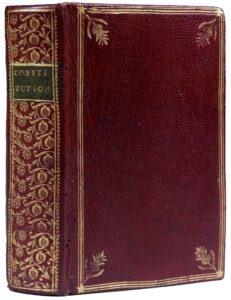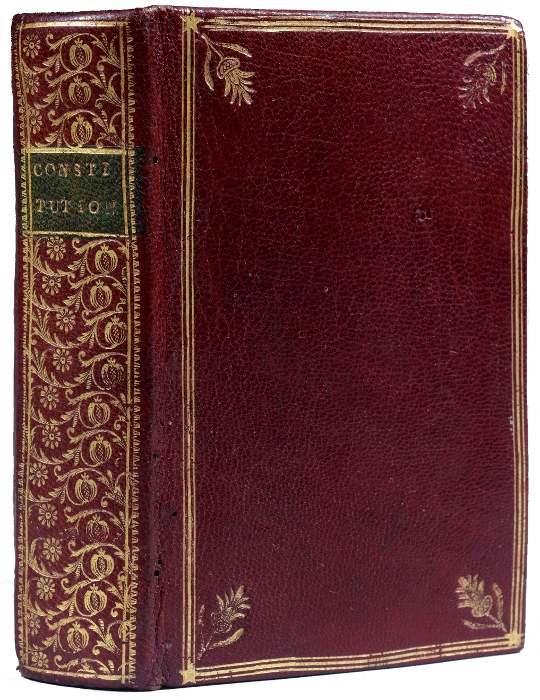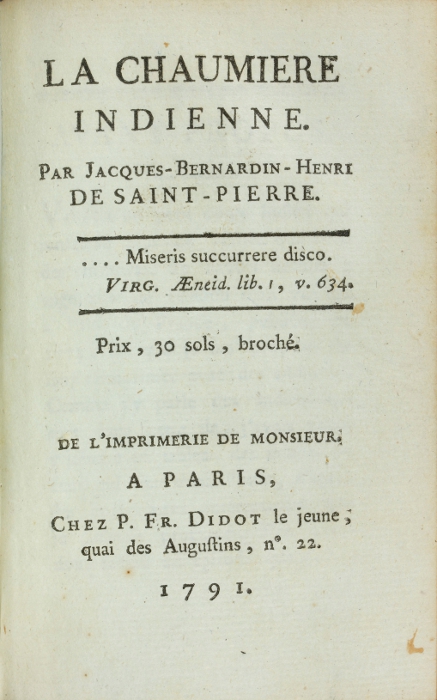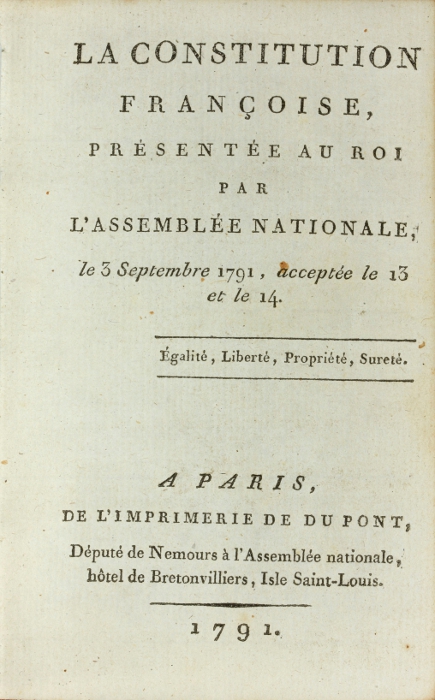A Paris, de l’Imprimerie de Du Pont, Député de Nemours à l’Assemblée nationale, hôtel de Bretonvilliers, Isle Saint-Louis, 1791.
[Followed by] : II/ GARNIER, Germain. De la propriété dans ses rapports avec le droit politique. A Paris, chez G. Clavelin, 1792.
[Followed by] : III/ SAINT-PIERRE, Bernardin de. La Chaumière indienne. A Paris, chez P. Fr. Didot le jeune, quai des Augustins, n°22, 1791.
3 works in 1 volume 18mo [119 x 77 mm.] of : I/ 113 pp., (1) bl.p., (1) bl.l.; II/ (2) ll., xxxvi pp., 208 pp.; III/ xlvii pp., (1) p., 130 pp. Bound in contemporary full red morocco, triple gilt fillet on covers, gilt fleurons at the corners, flat spine decorated with grotesques, green morocco lettering-piece, inner gilt border, blue doublures and endleaves, gilt edges. Contemporary binding.
« The first of our revolutionary charters » bound in contemporary full red morocco decorated with grotesques, followed by « De la propriété dans ses rapports avec le droit politique » by Garnier and by « La Chaumière indienne » by Bernardin de Saint-Pierre.
This edition of the Constitution, given by Du Pont de Nemours in Paris, starts with the Déclaration des droits de l’homme et du citoyen and continues with the Lettre du Roi portée à l’Assemblée Nationale par le Ministre de la Justice le 13 septembre 1791. In this letter the King swears loyalty to the Constitution and becomes « King of all the French people ». The volume also contains the Extracts of the minutes of the sessions of the National Assembly from the 14th and 30th of September 1791.
«This first Constitution, even with its slight imperfections, will always be one of the most venerable political monuments of human history; first of all because it represented the most perfect social pact to ever have governed some people, then because it opened a new era and inaugurated the era of justice and freedom, and because it was used as a model; finally, because the principles established by the Constitution successively penetrated into all the peoples’ legislation. On June 20th 1789, in the forever memorable scene of the Jeu de paume, the members of the Third Estate, threatened by all the factions of the Ancien Régime, had solemnly sworn to resist up to death, and not to disperse before having given a constitution to France, or, in other words, having established order, common law, justice, instead of anarchy, privilege and arbitrariness. ».
Delegate in 1789 in the States General by the bailiff’s court of Nemours, Pierre Samuel Du Pont de Nemours (1739-1817) sustainer of the French Revolution at first served in 1790 as president of the Constituent National Assembly, where he made numerous interventions in the economic, financial and fiscal questions. At the end of 1791, like all the other members of the Constituent, he swore not to run for the legislative elections. He became then unemployed and Lavoisier lent him some money to buy the printing office of the Hôtel de Bretonvilliers, the former printing office of the Farm general that had just been suppressed. Du Pont de Nemours printed the present Constitution in this printing office in 1791.
II/ First edition of this work of economy anonymously published soon after the French revolution. Count Germain Garnier (1754-1821) was a prosecutor in the Châtelet in 1789 when Madame Adelaide, the aunt of Louis XVI, hired him as a secretary. Named deputy in the States General, he sided with the royalist opposition and was part of the club of the Impartiaux, a monarchic club. Although he didn’t openly oppose the Revolution, he emigrated after August 10th 1792 and only came back to France when he had nothing to fear anymore.
« In this anonymous booklet that marks the début of the author as an economist, Garnier utters the principle that property is the constituent principle of any election right : at the time this opinion could only offend those who were supporting monarchy and who found the idea of having rights to be seditious, but also those who wanted to push the revolution towards a pure democracy. Garnier developed it with his clear, quiet and mathematically elegant style that were characteristic of Condillac. » (Biographie universelle, XV, 593).
III/ First edition of « La chaumière indienne ». Rahir, Bibliothèque de l’amateur, 1829 ; Tchemerzine, V, 651 ; Le Petit 572 ; Catalogue de Backer 1267.
« The essential value of this book lies in the art with which Bernardin de Saint-Pierre depicts a nature rich in colors and perspectives ; by developing the myth of a humanity being regenerated by nature, the author illustrates one of the literary motives characteristic of a certain time. » (Dictionnaire des Oeuvres, I, 707).
A beautiful copy gathering three famous historical or literary texts published soon after the Revolution, preserved in a contemporary red morocco binding with a flat spine decorated with grotesques.
Provenance : Guillaume-François-Charles Goupil de Préfeln (handwritten note on the endleaf) and Baron de Cougny Préfeln with engraved ex libris. Guillaume-François-Charles Goupil de Préfeln (1727-1801) was deputy in Alençon Third Estate at the Constituent Assembly and judge at the Supreme Court of Appeal in 1800.




